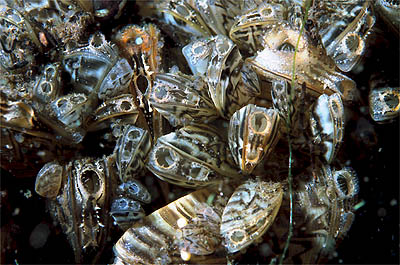
GIWS member researches zebra mussels with DNA testing
Tim Jardine featured in Weyburn this Week for his work on the invasive species
This article originally appeared in Weyburn this Week on July 17. To view the original, click here.
A University of Saskatchewan research project is using DNA testing to check for unwanted visitors in the province’s water bodies.
Invasive species such as zebra and quagga mussels cost industries and governments millions of dollars each year. Since their introduction from the Black Sea into the Great Lakes in the 1980s, preventing the spread of these tiny invaders has been a costly uphill battle.
Almost impossible to eliminate once established in a water body, these invasive mussels can severely impact aquatic habitats and devastate commercial and recreational fisheries. Mussels can also clog water intake structures and increase costs significantly for irrigation, power generation and municipal water supply.
Keeping tabs on invasive species is a challenge for a province like Saskatchewan. With confirmation of zebra mussels in Manitoba’s Cedar Lake, Lake Winnipeg, the Red River and in North Dakota, the importance of monitoring is paramount for the province.
The U of S research is led by professors Tim Jardine and Markus Hecker. The university has partnered with the Saskatchewan Ministry of Environment and Manitoba Water Stewardship on the project. “Living things shed parts of themselves into their environment,” explained Professor Jardine. “We are able to collect this environmental DNA from lakes and rivers, and it allows us to identify when a new species is present, sometimes sooner than would be visible in a search from shore or by boat.”
To date, nine locations have been tested along the shore of Lake Winnipeg, where zebra mussels are likely to be present. Those tests resulted in three positive detections. Jardine said researchers also sampled nine water bodies in Saskatchewan and found no positive detections.
“This technique is also being used by other researchers to identify rare and endangered species that can be hard to capture or observe using conventional sampling techniques,” Jardine said.
Water samples are collected from a water body, filtered and stored in very cold conditions to preserve any DNA present. Once back in the laboratory, the DNA is extracted from the filter. The DNA is then copied many times. The resulting “product” is then analysed.
“If the species’ DNA was present in the water sample, it will show up in the analysis,” Jardine said.
In total, the testing process takes about four days to complete and data is often available within a month of the sample collection. Several sites can be tested together, which could be very beneficial when looking at how many water bodies there are in a province like Saskatchewan.
“Once this technique is further developed, it will allow the provinces to detect and manage aquatic invasive species such as zebra mussels,” Jardine said.
The U of S research is supported by funding from the ministry’s Fish and Wildlife Development Fund.
As part of its prevention efforts, the province is asking all boaters to CLEAN, DRAIN and DRY their watercraft and all related equipment, to ensure it is free of invasive species before returning home from out of province, coming to visit, or moving between waters within Saskatchewan.
Watercraft inspections conducted by the ministry’s team of conservation officers are also being expanded throughout the province.
To report any sightings of aquatic invasive species, contact the Ministry of Environment or call the TIP Line at 1-800-667-7561.

